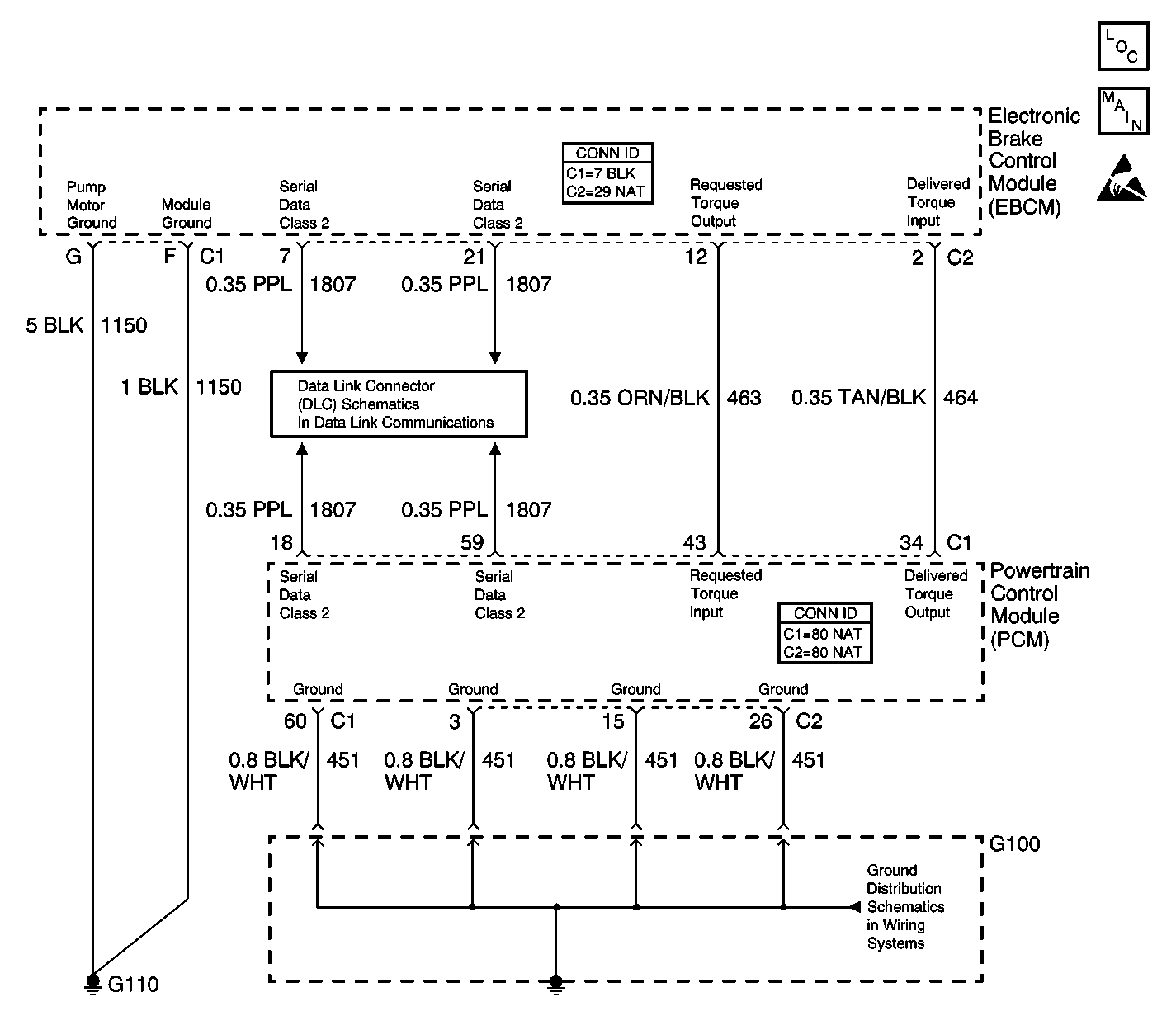
Circuit Description
The EBCM and the PCM simultaneously control the traction control. The EBCM sends a Requested Torque message via a pulse width modulated (PWM) signal to the PCM. The duty cycle of the signal is used to determine how much engine torque the EBCM is requesting the PCM to deliver. Normal values are between 10 and 90 percent duty cycle. The signal should be at 90 percent when traction control is not active and at lower values during traction control activations. The PCM supplies the pull up voltage that the EBCM switches to ground to create the signal.
Conditions for Running the DTC
The ignition is ON.
Conditions for Setting the DTC
The PCM diagnoses the requested torque PWM signal circuit and sends a class 2 serial data message to the EBCM indicating a fault is present. The PCM will set DTC P1571 and the EBCM will set DTC C1277. A fault exists in the circuit if the PCM detects one of the following conditions:
| • | The requested torque PWM signal is less than 5 percent duty cycle or greater than 95 percent duty cycle. |
| • | The requested torque PWM signal is not present for 10 seconds. |
Action Taken When the DTC Sets
| • | The EBCM disables the TCS for the duration of the ignition cycle. |
| • | The TRACTION CONTROL indicator turns ON. |
| • | The ABS remains functional. |
Conditions for Clearing the DTC
| • | The condition for the DTC is no longer present and the DTC is cleared with a scan tool. |
| • | The EBCM automatically clears the history DTC when a current DTC is not detected in 100 consecutive drive cycles. |
Diagnostic Aids
The following conditions can cause this concern:
| • | An open in the requested torque circuit. |
| • | An short to ground or voltage in the requested torque circuit. |
| • | A wiring problem, terminal corrosion, or poor connection in the requested torque circuit. |
| • | A communication frequency problem. |
| • | A communication duty cycle problem. |
| • | The PCM is not receiving information from the EBCM. |
| • | Loose or corroded EBCM ground or PCM ground. |
Test Description
The numbers below refer to the step numbers on the diagnostic table.
-
This step uses the scan tool to determine whether the requested torque signal has a valid duty cycle.
-
This step measures whether the requested torque signal has a valid duty cycle.
-
This step measures whether the EBCM requested torque signal has a valid frequency.
Step | Action | Value(s) | Yes | No | ||||||
|---|---|---|---|---|---|---|---|---|---|---|
1 | Did you perform the ABS Diagnostic System Check? | -- | Go to Step 2 | |||||||
2 |
Does the scan tool display DTC P1571 as current? | -- | Go to DTC P1571 Traction Control Torque Request Circuit in Engine Controls - 4.6L | Go to Step 3 | ||||||
3 | Inspect the EBCM ground and PCM ground, making sure each ground is clean and torqued to the proper specification. Refer to Circuit Testing and Wiring Repairs in Wiring Systems. Did you find and correct the condition? | -- | Go to Step 14 | Go to Step 4 | ||||||
With a scan tool, observe the Requested Torque parameter in the DRP/ABS/TCS data list. Does the scan tool display within the specified range? | 5-95% | Go to Testing for Intermittent Conditions and Poor Connections in Wiring Systems | Go to Step 5 | |||||||
Is the duty cycle within the specified range? | 5-95% | Go to Step 6 | Go to Step 7 | |||||||
Measure the DC Hz between the requested torque signal circuit and a good ground. Does the frequency measure within the specified range? | 121-134 Hz | Go to Step 11 | Go to Step 10 | |||||||
7 |
Important: Disconnecting the EBCM connector and turning ON the ignition could cause other modules to set loss of communication DTCs (Uxxxx). Once the EBCM is reconnected, the EBCM may set DTC C1298 PCM Class 2 Serial Data Link Malfunction. Does the voltage measure near or greater than the specified value? | 5 V | Go to Step 8 | Go to Step 9 | ||||||
8 |
Did you find and correct the condition? | -- | Go to Step 13 | Go to Step 11 | ||||||
9 |
Refer to Circuit Testing and Wiring Repairs in Wiring Systems. Did you find and correct the condition? | -- | Go to Step 13 | Go to Step 10 | ||||||
10 | Inspect for poor connections the harness connector of the PCM. Refer to Testing for Intermittent Conditions and Poor Connections and Connector Repairs in Wiring Systems. Did you find and correct the condition? | -- | Go to Step 13 | Go to Step 12 | ||||||
11 | Inspect for poor connections the harness connector of the EBCM. Refer to Testing for Intermittent Conditions and Poor Connections and Connector Repairs in Wiring Systems. Did you find and correct the condition? | -- | Go to Step 13 | Go to Step 13 | ||||||
12 |
Important: The replacement PCM must be programmed. Replace the PCM. Refer to Powertrain Control Module Replacement/Programming in Engine Controls - 4.6L. Did you find and correct the condition? | -- | Go to Step 13 | -- | ||||||
13 |
Important: Perform the setup procedure for the EBCM. An unprogrammed EBCM will
result in the following conditions:
Replace the EBCM. Refer to Electronic Brake Control Module Replacement . Did you complete the repair? | -- | Go to Step 13 | -- | ||||||
14 |
Does the DTC reset? | -- | Go to Step 2 | System OK |
